Free Asian Recipes from Korea for Cooking Korean Food
I love Korean food espeically Bul Kogi which is a Korean BBQ, grilling your own meat with friends and enjoying a wonderful and unique experience at the same time.
| Chicken Recipes | Beef Recipes | Seafood Recipes | Vegetarian Recipes | Dessert Recipes |
 In Korea, rice is served at every single meal. Sometimes you would get gruel or porridge for breakfast which
goes well for the elderly and children. At other meal times, steamed rice is cooked using the absorption
method (rice cooker) and is usually accompanied by various types of soup, meat, fish, vegetables and
of course, the ever popular kimchi,
which is usually a blend of radish and/or Chinese cabbage marinated in hot spices.
In Korea, rice is served at every single meal. Sometimes you would get gruel or porridge for breakfast which
goes well for the elderly and children. At other meal times, steamed rice is cooked using the absorption
method (rice cooker) and is usually accompanied by various types of soup, meat, fish, vegetables and
of course, the ever popular kimchi,
which is usually a blend of radish and/or Chinese cabbage marinated in hot spices. Sometimes the rice is combined with another type of grain such as barley or beans or a combination of both. Among the beans that are most commonly used are dried lima beans, azuki beans or red beans and soy beans or soybean products like bean curd, bean paste and soy sauce.
Beef (See Beef Recipes) is perhaps the most popular meat in Korea. Chicken (See Chicken Recipes) and pork are also used but mutton is never or rarely seen. If you will notice at any Korean grocery market, the beef is never sold (nor cooked) in one huge piece but rather in thin slices or cut into bite-size pieces; sometimes they are even beaten out to a papery thin slice. The beef is then kneaded well with a marinade and left for at least two to three hours so that it becomes not only tender but is flavored as well.
The most famous Korean charcoal girl or broil meal include the bulgogi or bulgalbi in which thin slices of meat is served on a hot grill set in the middle of the dining table. Guests are then welcomed to broil or grill their own meat. In Korea, you also have an abundance of seafood dishes (See Seafood Recipes) such as fried oysters hot pot or squid in vinegar and soy sauce just to name a two. Koreans, just like the Japanese uses seaweed or nori in many of their dishes.
The basic Korean diet at each meal consists of steamd rice, hot soup, one or two types of kimchies and a number of various meat and vegetable side dishes. You would also find an assortment of fruits as an after-meal refresher. In traditional Korean setting, the table setting is often classified into 3 chop, 5 chop, 7 chop, 9 chop or 12 chop according to the number of side dishes served. The average family takes about three to four side dishes along with the rice, soup and kimchi for everday Korean meal.
For fancy events, such as a wedding celebration or someone's birthday, you can expect to find a dozen or more delightful dishes of different kinds usually served according to the season. Different settings will reflect different occasions such as New Year's Day Table, Moon Festival Table, Baby's First Birthday, Remembering Ancestors Table, Day Table, Bride's Gift Table and there's even one for a Drinking Table. The table is usually set very low to the ground. The main dishes and side dishes are shared by all and is placed in the middle of the table. The rice and soup usually in front of each diner. Chopsticks and spoons are used as utensils.
The following is my version of Korean marinating sauces which comes from experimenting and through trial and error. Though I probably won't score high marks for authenticity, it's the closest I can come. This sauce will marinate about 1 lb of thinly sliced beef. Adjust according to your palatal taste. Marinate the meat at least a couple of hours before serving.
Basic Korean Marinate Sauce:
- 2 tsp honey
- 1/2 tsp ginger (grated fine)
- 1 clove garlic (crushed)
- 1 tsp sesame oil
- 2 tsp sesame seeds (toasted)
- 4 tsp light soy sauce
- 1 bunch spring onions or green onions (chopped)
- pepper to taste
Enjoy making Korean dishes as much as I have.
Korean Recipes
-
Index of New Korean Recipes:
- Korean Spicy Buckwheat Noodles NEW
- Korean Spicy Octopus NEW
- Korean Egg Sandwich NEW
- Korean Fish Cake Soup NEW
-
Korean Barbeque Chicken NEW
Chicken, Duck, Quail & Poultry Recipes:
- Braised Spicy Chicken (Dak Do Ri Tan)
- Ginseng Chicken Soup (Sam Gae Tang) popular
- Korean Chicken Soup - Version I
- Chicken Soup with Ginseng (Samgye Tang) - Version II
-
Spicy Chicken Wings (Dak Nal Ke Jo Rim)
Pork, Mutton, Beef, Veal and Lamb Recipes
- Eggs with Beef (Ganghwe)
- Korean Barbeque (Bul Kogi) popular
- Korean Dumpling Soup (Mandoo)
- Korean Oxtail Soup
- Pressed Boiled Pork (Twaejigogi Pyonyuk)
- Pork and Crab Fried Rice (Bokum Bahb)
- Spicy Chilled Beef (Jang Jo Rim)
-
Spicy Pork and Lamb Barbeque
Seafood Recipes
- Fried Oyster Hot Pot
- Seafood Barbeque (Shrimp, Scallop, Squid) popular
- Seafood Pancakes (Pa Jun) popular
- Spicy Octopus (Nak Ji Bok Gum)
- Squid in Vinegar and Soy sauce
-
Tuna Tartar (Cham Chi Hwe) popular
Vegetarian Recipes
- Korean Barbeque Tofu
- Korean Bean Sprouts
- Korean Relish (Chonggak Kimchi)
- Korean Seasoned Potatoes
-
Salted Soy Eggs (Taigyal Changjorim)
Noodles, Rice & Bread Recipes
- Korean Vegetarian Dish (Chap Chae) popular
- Rice Medley (Bibimbap) popular
- Rice with Mushrooms (Song-I Bahb)
-
Sesame Noodle Salad
Dessert & Sweets Recipes
- Apple Wine (Sagwaju)
- Half Moon Rice Cakes (Songpyon) popular
- Herbal Teas (Ginseng Tea, Date Tea, Ginger Tea)
- Persimmon Punch (Sujunggwa) popular
- Sweet Rice Cake (Yak Shik)
- Sweet Rice Punch (Sik Hae) popular
Chicken Recipes
Beef & Pork Recipes
Seafood Recipes
Vegetarian Recipes
Dessert Recipes
 Meaning to cook meat by the fire and is considered by many Koreans as a national dish.
Meats are sliced very thinly and marinated in various types of sauces.
Meaning to cook meat by the fire and is considered by many Koreans as a national dish.
Meats are sliced very thinly and marinated in various types of sauces. Or white Radish. Larger and milder than small red radish. Can be dressed and eaten raw, sliced and shredded
in stir-fries, stews, soups and pickled or grated in dipping sauce.
Or white Radish. Larger and milder than small red radish. Can be dressed and eaten raw, sliced and shredded
in stir-fries, stews, soups and pickled or grated in dipping sauce.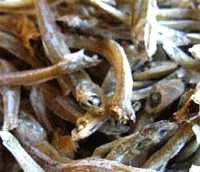 Small, silver salt-water fish used to enhance flavor of soup, stew and sauce. Make sure they are washed and
de-headed before use. Can be made into fish stock soup.
Small, silver salt-water fish used to enhance flavor of soup, stew and sauce. Make sure they are washed and
de-headed before use. Can be made into fish stock soup.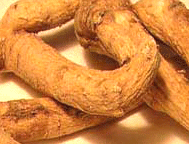 Widely regarded as a rejuvenating herb, Koreans ascribe much medicinal power to this famous root. Prices can
be quite high for the finest grade of this root. In addition to tea, ginseng may be cooked with foods such as
stuffed chicken, or simmered in soy sauce to make a dressing. Common: American Ginseng.
Widely regarded as a rejuvenating herb, Koreans ascribe much medicinal power to this famous root. Prices can
be quite high for the finest grade of this root. In addition to tea, ginseng may be cooked with foods such as
stuffed chicken, or simmered in soy sauce to make a dressing. Common: American Ginseng.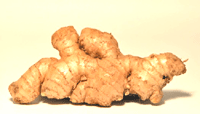 Used often as a spice, the mature ginger is spicier and more pungent than young ginger which has a lighter taste. In
most cases, ginger should be peeled before shredding, mincing etc.
Used often as a spice, the mature ginger is spicier and more pungent than young ginger which has a lighter taste. In
most cases, ginger should be peeled before shredding, mincing etc. Is a sweet low-alcohol rice wine used in Japanese and Korean cooking, sometimes referred to
simply as rice wine but should not be confused with sake which is the Japanese rice wine made for
drinking.
Is a sweet low-alcohol rice wine used in Japanese and Korean cooking, sometimes referred to
simply as rice wine but should not be confused with sake which is the Japanese rice wine made for
drinking. Also known as Japanese pear, Asian pear and apple pear, this juicy and crispy fruit usually comes in yellow
or brown skinned. Can be eaten raw or cooked.
Also known as Japanese pear, Asian pear and apple pear, this juicy and crispy fruit usually comes in yellow
or brown skinned. Can be eaten raw or cooked.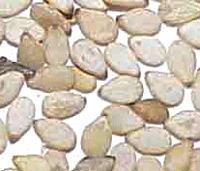 Used extensively as a seasoning in marinades, sauces and vegetable side sides as well as garnish.
Toasting will bring out the full aroma and flavor of the seeds. Do not keep for long as they will go rancid.
Also comes as black sesame seeds which has an earthier and richer taste.
Used extensively as a seasoning in marinades, sauces and vegetable side sides as well as garnish.
Toasting will bring out the full aroma and flavor of the seeds. Do not keep for long as they will go rancid.
Also comes as black sesame seeds which has an earthier and richer taste.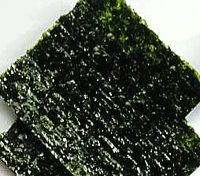 Seaweed (Kim)
Seaweed (Kim) Also known as Chinese Black Mushrooms, sold fresh or dried. Dried ones have stronger flavor and needs
to be soaked in warm water before use.
Also known as Chinese Black Mushrooms, sold fresh or dried. Dried ones have stronger flavor and needs
to be soaked in warm water before use.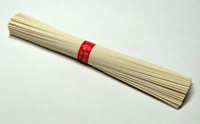 Resembling Italian angle hair pasta, somen is the thinnest Asian noodle avaiable. Made from white
flour and can be cooked and served chilled.
Resembling Italian angle hair pasta, somen is the thinnest Asian noodle avaiable. Made from white
flour and can be cooked and served chilled. This soy sauce is a brownish-black salty liquid that is made by cooking fermented soybean cakes
with water and salt. Each household in Korean used to make their own soy sauce in the spring; in fact
you may find that some still follow this tradition. They are mild and add good flavor to any food. Japanese
soy sauce is less salty but sweeter than Korean soy sauce.
This soy sauce is a brownish-black salty liquid that is made by cooking fermented soybean cakes
with water and salt. Each household in Korean used to make their own soy sauce in the spring; in fact
you may find that some still follow this tradition. They are mild and add good flavor to any food. Japanese
soy sauce is less salty but sweeter than Korean soy sauce.